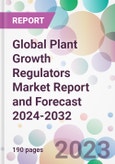According to the report, the global plant growth regulator market is projected to grow at a CAGR of 10.4% between 2024 and 2032 reaching a value of approximate USD 9.5 billion by 2032. Aided by the heightened demand for sustainable agricultural practices and the diversification of plant growth regulators in crop production, the market is expected to grow significantly by 2032.
Plant growth regulators (PGRs) play an instrumental role in modulating the growth and development of plants. These organic compounds, whether applied externally or produced naturally within plants, influence physiological processes, such as flowering, fruit development, dormancy, and germination. Given their capacity to augment yield and improve the quality of produce, PGRs have garnered immense traction in modern agriculture, more so in the realms of horticulture and floriculture.
One of the primary forces propelling the plant growth regulator market growth is the escalating global demand for food. With the burgeoning world population, there is an unprecedented pressure on the agricultural sector to enhance productivity. Plant growth regulators, in this context, emerge as vital tools to optimise plant development, thereby assuring improved crop yield and quality.
Moreover, the shifting focus towards sustainable agricultural practices is impacting the plant growth regulator market outlook. The rising awareness about the environmental consequences of excessive chemical use has led to the adoption of eco-friendly alternatives. PGRs, given their ability to reduce the reliance on chemical fertilisers, have witnessed a surge in demand among environmentally-conscious farmers.
The broadening applications of plant growth regulators in the agricultural landscape cannot be overlooked. In addition to their traditional roles in crop yield enhancement, PGRs are increasingly being employed for stress resistance, particularly in areas facing extreme weather conditions. Their use in enhancing drought and salinity tolerance in crops is a testament to their versatility and indispensability.
As per the plant growth regulator market analysis, the ornamental and turf sectors also lean heavily on plant growth regulators. With urbanisation on an upswing and aesthetic landscaping becoming a norm, there’s a marked rise in the demand for PGRs to maintain lawns, gardens, and ornamental plants. The capability of PGRs to regulate growth, extend the flowering period, and improve the visual appeal of plants amplifies their significance in this sector.
Plant growth regulators (PGRs) play an instrumental role in modulating the growth and development of plants. These organic compounds, whether applied externally or produced naturally within plants, influence physiological processes, such as flowering, fruit development, dormancy, and germination. Given their capacity to augment yield and improve the quality of produce, PGRs have garnered immense traction in modern agriculture, more so in the realms of horticulture and floriculture.
One of the primary forces propelling the plant growth regulator market growth is the escalating global demand for food. With the burgeoning world population, there is an unprecedented pressure on the agricultural sector to enhance productivity. Plant growth regulators, in this context, emerge as vital tools to optimise plant development, thereby assuring improved crop yield and quality.
Moreover, the shifting focus towards sustainable agricultural practices is impacting the plant growth regulator market outlook. The rising awareness about the environmental consequences of excessive chemical use has led to the adoption of eco-friendly alternatives. PGRs, given their ability to reduce the reliance on chemical fertilisers, have witnessed a surge in demand among environmentally-conscious farmers.
The broadening applications of plant growth regulators in the agricultural landscape cannot be overlooked. In addition to their traditional roles in crop yield enhancement, PGRs are increasingly being employed for stress resistance, particularly in areas facing extreme weather conditions. Their use in enhancing drought and salinity tolerance in crops is a testament to their versatility and indispensability.
As per the plant growth regulator market analysis, the ornamental and turf sectors also lean heavily on plant growth regulators. With urbanisation on an upswing and aesthetic landscaping becoming a norm, there’s a marked rise in the demand for PGRs to maintain lawns, gardens, and ornamental plants. The capability of PGRs to regulate growth, extend the flowering period, and improve the visual appeal of plants amplifies their significance in this sector.
Market Segmentation
The market can be divided based on type, crop type, application, and region.Market Breakup by Type
- Auxins
- Ethylene
- Gibberellins
- Cytokinins
- Abscisic Acid
Market Breakup by Crop Type
- Fruits and Vegetables
- Cereals
- Oilseeds and Pulses
- Turf and Ornamentals
- Others
Market Breakup by Application
- Plant Growth Promoters
- Plant Growth Inhibitors
Market Breakup by Region
- North America
- Europe
- Asia Pacific
- Latin America
- Middle East and Africa
Competitive Landscape
The report looks into the market shares, plant turnarounds, capacities, investments, and mergers and acquisitions, among other major developments, of the leading companies operating in the global plant growth regulator market. Some of the major players explored in the report are as follows:- Sumitomo Chemical Co., Ltd
- BASF SE
- Syngenta Crop Protection, LLC
- Nufarm Ltd
- Bayer Crop Science AG
- Corteva, Inc.
- Tata Chemicals Limited
- United Phosphorus Ltd
- FMC Corporation
- WinField Solutions LLC
- Valent BioSciences Corporation
- Others
Table of Contents
1 Preface2 Report Coverage - Key Segmentation and Scope4 Key Assumptions7 Opportunities and Challenges in the Market17 Key Trends and Developments in the Market
3 Report Description
5 Executive Summary
6 Market Snapshot
8 Global Plant Growth Regulators Market Analysis
9 North America Plant Growth Regulators Market Analysis
10 Europe Plant Growth Regulators Market Analysis
11 Asia Pacific Plant Growth Regulators Market Analysis
12 Latin America Plant Growth Regulators Market Analysis
13 Middle East and Africa Plant Growth Regulators Market Analysis
14 Market Dynamics
15 Trade Data Analysis (HS Code - 380893)
16 Competitive Landscape
List of Key Figures and Tables
Companies Mentioned
- Sumitomo Chemical Co. Ltd
- BASF SE
- Syngenta Crop Protection
- Nufarm Ltd
- Bayer Crop Science AG
- Corteva Inc.
- Tata Chemicals Limited
- United Phosphorus Ltd
- FMC Corporation
- WinField Solutions LLC
- Valent BioSciences Corporation
Methodology

LOADING...








